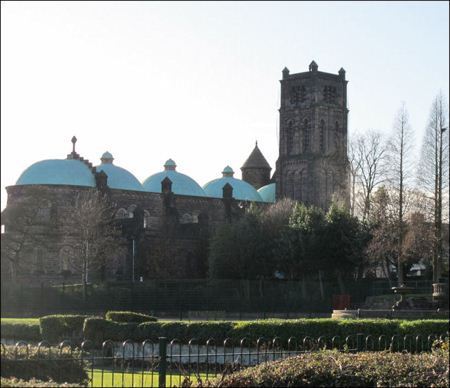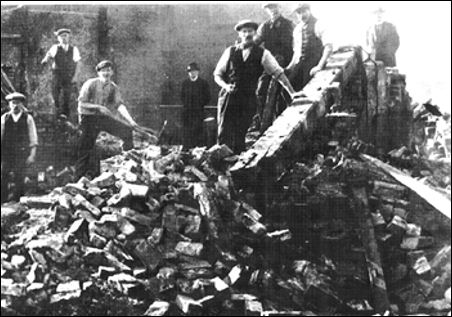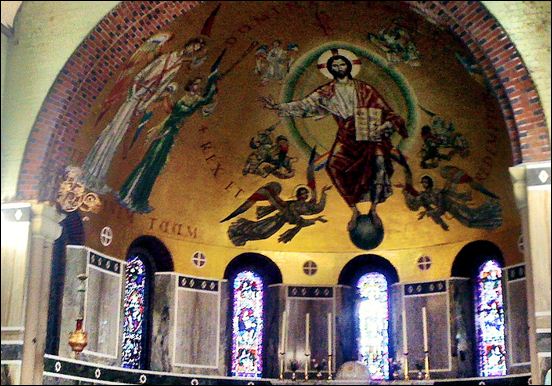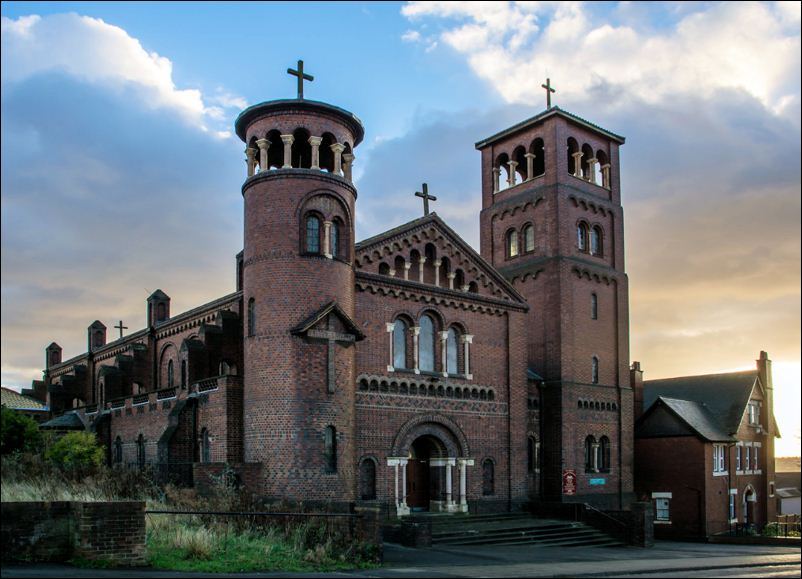|
St Joseph’s is one of the finest churches in the city, and is a Mother Town landmark, its Romanesque towers visible from the A500 and other local vantage points. St Joseph’s is solidly built from good local materials – its multi-coloured bricks were supplied by the Fenton Colliery Company – and has endured where other buildings have fallen.
Father Miller will also be responsible for the Roman Catholic Church of the Sacred Heart a short hop down the road in Tunstall, continuing the two churches intertwined stories.

Church of the
Sacred Heart, Tunstall
J.S. Brocklesby dsigned both St. Joseph's and the Church of the Sacred Heart
Both St Joseph’s and the Church of the Sacred Heart were commissioned in 1925, by their two respective priests, Father William Browne (St Joseph’s), and Father Patrick Joseph Ryan (Church of the Sacred Heart). The two priests were good friends, but often fell out, perhaps due to their competitive nature, and both appointed the same architect – J.S. Brocklesby – to build their new churches.
Father Ryan’s brief to Brocklesby was simple: to trump the local protestants and build the biggest and most beautiful church in the area. But given his friendly rivalry with Father Browne, and the fact that they were both building churches at the same time, you have to wonder whether he was also looking to trump his friend too.
Brocklesby took up the challenge, but he had himself an infuriating client, and Father Ryan took him all over Europe to view continental churches, where his own ideas grew and grew. An exasperated Brocklesby never completed his Tunstall commission, leaving Father Ryan to his own devices and concentrating on his work for Father Browne in Burslem.

the area was demolished
by unemployed locals
photo:
Friends of St. Joseph's
Both churches were planned at a time of great hardship in the midst of the Great Depression, and both priests utilised local labour to help complete their projects. Father Browne offered the local unemployed a meal in return for a few hours on-site, and following encouragement from the local MP Andrew MacLaren, and with the help of Gordon Forsyth – that giant of local art, design and ceramics – engaged young parishioners to make and decorate the church’s stained-glass windows, fifty of them benefiting from free courses ran by Forsyth in the Wedgwood Memorial Institute.
St Joseph’s was completed in 1927 after a build programme of almost three years, Father Browne beating Father Ryan to the punch, who completed the Church of the Sacred Heart in 1930. Both Gordon Forsyth and his daughter Moira became heavily involved in the decoration of St Joseph’s, and alongside Father Browne, Moira produced a stunning painting for the church’s sanctuary ceiling – ‘Christ in Glory’ – the working relationship between Father Browne and the Forsyths led to a long and enduring friendship.
Today, St Joseph’s is in need of a little TLC, with some roof repairs required to prevent internal damage from water penetration, and Peter Lucas, Father Miller and the Archdiocese are working hard to secure grant funding which will go some way to securing the future of this beautiful building.
But they also recognise that St Joseph’s is not an island, and their ideas go beyond simply restoring the church. There is talk of using its restoration as the catalyst to strengthen its bond with the local community, and developing links with local schools, the idea being that the church could be used as an educational tool for students studying art, architecture, and history.

the forlorn Burslem Sunday School
Portico
And the refurbishment of St Joseph’s and the wider plans could also provide the impetus to regenerate the western part of the Mother Town, with action urgently needed to address the nearby Hill Pottery site, and finally find a solution to the Burslem Sunday School Portico, which has stood forlorn for over thirty years.
This would be a revival of the spirit that saw St Joseph’s built in the first place, and would be a much welcomed way to start to thaw the post-crash chill that has greatly affected communities across North Staffordshire, and to create some hope for the future. In recent times the Church of England has feuded with the Government over welfare policy and the increase in foodbanks, with some suggesting that on certain issues, our various faiths should steer clear. But the history of St Joseph’s and the plans for the future demonstrate that actually, our faiths can be a positive enabler of change.

'Christ in Glory' by
Moria Forsyth
photo:
Matthew Doyle
We can learn a lot from the story of St Joseph’s, from how the church was designed and built using local labour and know-how, and locally sourced and produced materials. Times were tough in the mid-1920s, as they are today, and big local characters – Father Browne, Father Ryan, Andrew MacLaren, the Forsyths – stepped up to the plate and involved local people in their projects, which provided simple solutions at the time, and an enduring legacy. People did not forget: when Father Ryan passed away in 1951, it is said that his funeral procession was five miles long and brought the area to a standstill; an amazing show of respect and affection.
Moira Forsyth went on to become one of the finest producers of stained-glass windows in the country, and when she died in 1991, the priest at her funeral recounted a story of a child that had been on a trip to visit a cathedral, telling her mother: “we saw gold and silver, marble and carvings, and we saw some saints up near the ceiling”. “Some saints, dear?” asked her mother. “Yes, you know, those people who let the light shine through them”.
Those people who let the light shine through them is a fitting description of all of those that have left Burslem with a fine legacy in St Joseph’s. We must let that light shine once more.

Dave
Proudlove - January 2015
|
![]() back to Another 'Grand Tour' index
back to Another 'Grand Tour' index![]()
![]()

![]()
![]()